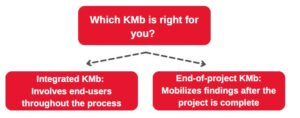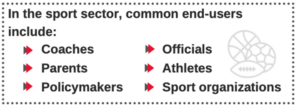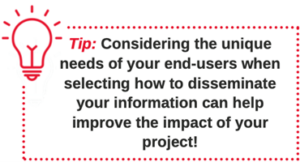Snowmobiling and ice skating on ponds, lakes or rivers that are not adequately frozen can put individuals at risk. Checking ice thickness and colour before going on to it is key to preventing injuries. Keep in mind ice thickness can be impacted by many factors, including the time of year, the size of the body of water and undercurrents.
Research shows that video assistance referee (VAR) technology in professional soccer has helped with officials’ decision-making, but has disrupted the flow of the game. To improve speed and accuracy, FIFA debuted a new technology at the 2022 World Cup that automates the detection of offsides. Using multiple cameras and artificial intelligence software, officials were able to make accurate decisions within seconds.
An organization’s equity, diversity, and inclusion strategy and decision-making should be informed by the people it intends to serve. Intentionally including demographics in data collection can provide meaningful and valuable insights. For example, the data collected for MLSE LaunchPad’s Change the Game project revealed that 10% of the youth surveyed had experienced racism in sport. When broken down by race, that number jumped to 33% and 28% for Black and Indigenous youth respectively.
For sport organizations, stakeholder engagement is a real-world data source that can help them to better understand their organization and programs and make adjustments. To engage stakeholders thoughtfully, organizations should make sure to receive feedback openly (without getting defensive), consider the format (for example, anonymous survey) and develop a plan for reporting back (such as a summary report posted online or sent in a newsletter).
The sport sector is constantly striving to enhance injury prevention mechanisms. Sports injury surveillance systems that provide quality data are critical when creating and evaluating injury prevention strategies. These strategies should be incorporated at all levels to create stronger standards for data reporting, monitoring injury and developing sport safety strategies.
Relying on top line averages and rankings can perpetuate inequality in sport. But examining data through the lens of demographic factors can help organizations to take meaningful action toward equity in sport. MLSE LaunchPad’s 4 pillars of Transparency, Trust, Trying (it out) and Talking (it out) can help sport organizations improve their measurement and evaluation plans.
As we transition into an increasingly online world, how can sport organizations not only cope, but thrive? What are the potential benefits of social media for sport organizations of all levels, and what are the downsides?
SIRC put these questions to Michael Naraine, an Associate Professor of Sport Management at Brock University. Naraine’s research specializes in digital sport marketing and management, including social media management and fan engagement. Some of his recent publications have focused on training sport administrators in analytics, wi-fi usage at NBA games, and the Toronto Raptors’ #WeTheNorth marketing campaign.
Naraine offered advice for sport organizations looking to “futureproof” themselves in an ever-changing digital landscape.
SIRC: What does the digital world mean for sport organizations?
MN: I think the easiest, simplest response is that it’s time to prepare for change. Back in the 80s and early 90s National Sport Organizations (NSOs) used to be administered by people showing up to kitchen tables or small board rooms to talk about how to manage our sports. Now in 2022, some NSOs have 8-digit budgets. It’s not a kitchen table type atmosphere anymore. It’s more of a corporate boardroom style (or at least it’s pushing to that frontier).
 Think about the way that [organizations] communicated back in the early to mid-90s. They were faxing things, writing memos, and using snail mail, and then there was a slow, gradual transition towards email and text messaging. There’s been a natural progression as technology advanced over the last 5-10 years and we’re seeing that change timeline really start to shorten.
Think about the way that [organizations] communicated back in the early to mid-90s. They were faxing things, writing memos, and using snail mail, and then there was a slow, gradual transition towards email and text messaging. There’s been a natural progression as technology advanced over the last 5-10 years and we’re seeing that change timeline really start to shorten.
As a result, organizations need to be dealing not just with the “now” (“oh, we need to stop using fax machines, we need to start using social media more, and we need to start using mobile phones as opposed to landlines”) but to start to think about futureproofing themselves.
That’s really the crux of the question: what are you doing now? Not for next week, but to prepare for the next 3 to 5 years?
We know from research and practice that if you spend and dedicate 100% of your time dousing the fire that’s in front of you, that’s not an effective use of your time as an administrator. 60% of the operation should be focused on the day to day, and 30 to 40% should be focused on a long-term time horizon.
Organizations need to understand that change is inevitable. It’s what we do to prepare ourselves for that inevitable change that will separate the NSOs that are going to be on the forefront versus the NSOs and the P/TSOs that are going to left to the margins.
SIRC: We’re talking about the sport context, but that’s true of any field or organization, right?
MN: Absolutely. But particularly when we add in the sport context, the default response that everyone tends towards is “we don’t have capacity.”
I’ll give you a more specific example: in 2017, some of my research looked at Canadian NSOs and there were a few administrators who would say, “if you gave me a cash injection, I wouldn’t put it into digital, I would get a new coach. And I would get that coach because that coach would theoretically get better athlete results. Those results win medals, and the medals make me more money.”
So, there’s that tendency to think of the other “extracurriculars” as we’ll call things like digital, as erroneous or capacity drainers. But there’s a missed opportunity with the Canadian sports system to think about these elements not as capacity drainers, but as capacity enhancers.
 We’ve seen this in other sectors where digital has been used to generate more revenue, whether it’s through sponsorship or to increase membership. For example, rather than having a press conference, which is an expensive endeavor, social media is a great way to broadcast to your public without those traditional expenditures.
We’ve seen this in other sectors where digital has been used to generate more revenue, whether it’s through sponsorship or to increase membership. For example, rather than having a press conference, which is an expensive endeavor, social media is a great way to broadcast to your public without those traditional expenditures.
SIRC: How does one deal with changes like bringing social media into your organization?
MN: There’s a natural inclination to want to “keep up with the Kardashians.” Like, “oh here’s this cool new thing we’ve got to do it because it’s cool and we need to stay relevant.” That’s the antithesis of good organizational management, period. No business should be so reactive.
So, the very first thing to answer your question, is to make sure that you have good club governance. Governance is not sexy, but it’s important. And it connects into the next piece, which is that you need to have a strategy focused on digital.
If you don’t have a digital strategy at the board level, then you’re just operating for the sake of operating. It’s a capacity drainer to expend resources without a plan.
 You need to have board members that are diverse and reflective of different skills and competencies. If there are board members missing in terms of revenue generation, sponsorship, information technology, communication, then those are things that the organization should be looking to add (and could consider using a skills matrix to identify). Board meetings need to involve talking about: what does our digital strategy look like? How are we digitally futureproofing our organization over this next quad?
You need to have board members that are diverse and reflective of different skills and competencies. If there are board members missing in terms of revenue generation, sponsorship, information technology, communication, then those are things that the organization should be looking to add (and could consider using a skills matrix to identify). Board meetings need to involve talking about: what does our digital strategy look like? How are we digitally futureproofing our organization over this next quad?
That doesn’t mean just parachuting a millennial or Gen Z in there and hoping that because they’re of this younger generation they naturally know what they’re doing. That’s a silly way to go about doing business.
The third piece is to evaluate. Look at the trends, do some social listening, look at the metrics. What type of engagement did we get? What was good, what was bad? What time of day, what time of month, what time of the year did it work out for us? What is our calendar looking like for the next season or the next calendar year? Start to populate an action plan for that and then execute.
SIRC: Your answer reminds me of the saying: “if you don’t rise to the level of your goals you fall to the level of your systems.”
MN: Totally.
SIRC: Are there any downsides to social media use for organizations that that you would try to avoid, caution upon, or, you know, sort of plan before you act?
Sport organizations, particularly those in the Canadian sports system, have tended to use social media from more of a standpoint of “we’ll post results, and then we’ll post that we have an upcoming event,” and there’s not a lot of engagement. We need to remember that social media is about being social.
The most effective organizations have a coherent strategy that’s being implemented. And that strategy and those guidelines involve the temperament and the personality of the organization and how that is going to exude through the content that’s being posted and the engagements that will take place.
 That comes back to the problem of parachuting a 20-year-old person in there who may not necessarily reflect the best parts of the organization or might go out and do something or say something or maybe has [the organization’s socials] on their personal cell phone.
That comes back to the problem of parachuting a 20-year-old person in there who may not necessarily reflect the best parts of the organization or might go out and do something or say something or maybe has [the organization’s socials] on their personal cell phone.
Other things to consider: Who has access to the social media accounts? What are the rules of engagement?
You don’t want to amplify misinformation or continue inappropriate conversations. Again, you have to ask: what is the personality of our organization? Are we more extroverted? Are we trying to be a little bit more sarcastic and edgy? Or are we more professional, perhaps more, I’ll use the term “uptight?” Wherever the lines are, those lines of demarcation need to be drawn.
Many sport organizations collect data on their programs and best practices, but what happens with those findings? Unfortunately, this data often gets piled into internal reports and largely forgotten. This means that valuable learnings aren’t shared with those who can use them to inform future practices and advance the sport system.
As many organizations are ramping up for the upcoming sports season and are beginning to think about program evaluations, now is a good time to consider how organizations can use knowledge mobilization (KMb) principles to optimize evaluation findings.
In this blog, SIRC will review what knowledge mobilization is and why it’s crucial for the sports sector. SIRC will also provide tips and resources to help organizations plan knowledge mobilization activities.
Understanding knowledge mobilization
Knowledge mobilization is the process of sharing evidence-based findings with an audience who can use those findings in practice.
Depending on the knowledge you plan to share, your goals with your knowledge mobilization may vary. In the sports sector, common goals of knowledge mobilization are to:

Knowledge mobilization helps close the gap between what is known and what is done. Closing this “knowledge-to-action” gap can advance the sport sector by providing sport stakeholders with information that enables them to enhance practice, policies and programs. For example, knowledge mobilization can be used to synthesize the latest evidence on the topic of Safe Sport to inform the creation of policies and protocols that encourage safe, welcoming and inclusive environments for everyone involved in sport.

Mobilizing your knowledge
You may consider mobilizing knowledge whenever you complete a research project or evaluation with findings that could impact the current state of policies, programs or practice in the sport sector. This could include research and evaluation projects that you complete internally in your organization or in partnership with an academic researcher or institution.
For example, suppose you were evaluating the barriers newcomers to Canada face to participating in your community’s youth hockey program. After completing your evaluation, you could share your findings internally to identify strategies that may help improve accessibility and participation. You could also share these findings externally to begin discussions with other organizations who are facing or have faced similar challenges. Sharing your findings and best practices often leads to positive discussions and collaborations, which help move sport forwards.
While knowledge mobilization activities often happen at the end of a project or evaluation like in the example above, this is not always the case. You may choose to engage in integrated knowledge mobilization, which is when you work with a group of knowledge users throughout your evaluation or project.

With integrated knowledge mobilization, you rely on the unique expertise and experiences of your end-users to inform every step of the research project, from identifying your research question to sharing your research findings. Taking a more integrated approach to your knowledge mobilization helps ensure that you are answering questions that your end-users have and that the way you disseminate the findings will be relevant and meaningful to them.
Identifying how and with whom to share your knowledge
Knowledge mobilization deliverables can take many forms, including but not limited to infographics, videos, reports, workshops and social media posts. When selecting how you will mobilize your knowledge, it is important to consider with whom you hope to share the knowledge, as different groups have different learning styles and preferences. For example, if you are targeting athletes with your dissemination, you may rely primarily on social media. However, when targeting coaches, you may rely more on videos or infographics that could be shared within a newsletter or learning module. In many cases, sharing your knowledge using various dissemination tools is beneficial as it helps ensure you reach all your targetted end-users.

Tips to help you get started
- Think about what knowledge you want to share. Consider why sharing this knowledge is important. How will it contribute to the sport sector?
 Identify your end-users. Think about what end-user(s) you want to reach with this knowledge. Why is it important that they learn about this information?
Identify your end-users. Think about what end-user(s) you want to reach with this knowledge. Why is it important that they learn about this information? - Create a list of key messages. Identify the key points that you want to share. Make sure these points are clear, concise and written at a level your targeted end-users will understand.
- Consider how you want to share your knowledge. Look into different dissemination tools and identify which will be most appropriate for your end-users. When deciding on the dissemination tool(s) you will use, you should also consider the timeline for your project and the cost of the different dissemination tools.
Recommended resources
- Ontario Centre of Excellence for Child & Youth Mental Health – Knowledge Mobilization Toolkit: http://www.kmbtoolkit.ca
- Government of Canada – Knowledge Translation Planner: https://www.canada.ca/en/health-canada/corporate/about-health-canada/reports-publications/grants-contributions/knowledge-transfer-planner.html
- The Hospital for Sick Children – Knowledge Translation Planning Template: https://www.sickkids.ca/contentassets/4ba06697e24946439d1d6187ddcb7def/79482-ktplanningtemplate.pdf
- The Hospital for Sick Children – The Plain Language Writing Checklist: https://www.sickkids.ca/contentassets/92c5abda231e44b6832f5e3effeacdf8/plain-language-checklist_jan2017-sickkids-kt-program.pdf

Using data can help sport organizations plan quality programs with gender equity at their centre. Data collection can encourage better decision-making, help improve resource allocation, and create buy-in among stakeholders. Online toolkits, such as Same Game, help organizations use data to turn gender equity ideas into reality.
Before implementing new technology into your program, first ask yourself, can the technology be believed? Assessing the validity and reliability of a new technology is one way to determine its credibility. Validity assesses if the technology is measuring what it promises to measure, while reliability speaks to its consistency and degree of error when providing measurements.
